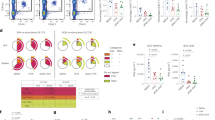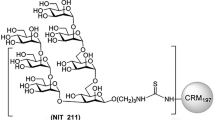Abstract
The T-cell receptor recognizes peptides bound to the major histocompatibility complex antigens. Synthetic peptides corresponding to microbial epitopes can efficiently stimulate the in vitro proliferation of T-cell hybridoma or in vivo primed T cells. However, the in vivo immune responses elicited by synthetic peptides are weak because of their short half-life and poor immunogenicity. We previously showed that a genetically engineered immunoglobulin (Ig-HA), in which the CDR3 region of VH gene was replaced with a viral peptide recognized by CD4+ T cells, was able to deliver this epitope in the correct frame to antigen-processing cells that efficiently presented the peptide to T cells. Recently, we developed an enzymatic method to assemble viral peptides on the sugar moieties of immunoglobulins without alteration of the biological functions of either molecule. The viral peptide carried by these conjugates was twenty times more efficient in activating a T-cell hybridoma than the free peptide as calculated on a molar basis. We show that such conjugates are able to prime in vivo the precursors of peptide-specific T cells and to induce proliferation of naive lymphocytes from transgenic mice expressing a peptide-specific T-cell receptor in both CD4 and CD8 T-cell subsets. Our results suggest that peptides enzymatically linked to the carbohydrate moieties of immunoglobulins, using galactose residues as peptide acceptor, can be used as a safe and efficient delivery system of protective epitopes for the prevention of infectious diseases. The enzymatic engineering of immunoglobulins may also allow the development of immuno-therapeutic agents to deliver antagonist peptides to autoreactive T cells or to direct immunomodulatory agents such as interleukins or cytolytic drugs to tumor cells.
This is a preview of subscription content, access via your institution
Access options
Subscribe to this journal
Receive 12 print issues and online access
$209.00 per year
only $17.42 per issue
Buy this article
- Purchase on Springer Link
- Instant access to full article PDF
Prices may be subject to local taxes which are calculated during checkout
Similar content being viewed by others
References
Leclerc, C. (ed). 1994. Immunogenicity of foreign epitopes expressed in chimeric molocules. Int. Rev. Immun. 11: 103–167.
Billeta, R., Hollingdale, M.R., and Zanetti, M. 1991. Immunogenicity of an engineered internal image antibody. Proc. Natl. Acad. Sci. USA 88: 4713–4717.
Zaghouani, H., Steinman, R.M., Novacs, R., Shah, H., Gerhard, W.V., and Bona, C.A. 1993. Presentation of a viral peptide T-cell epitope expressed in the CDR3 region of a self immunoglobulin molecule. Science 259: 224–227.
Zaghouani, H., Anderson, S.A., Kennedy, R.C., Mayer, L., and Bona, C. 1995. Induction of antibodies to the human immunodeficiency virus type I by immunization of baboons with immunoglobulin molecules carrying the principal neutralizing determinant of the envelope protein. Proc. Natl. Acad. Sci. USA 92: 631–635.
Zaghouani, H., Krystal, M., Kuzu, H., Morah, T., and Bona, C. 1992. Cells expressing an heavy chain immunoglobulin gene carrying a viral T-cell epitope are lysed by specific cytolitic T cells. J. Immunol. 148: 3604–3609.
Lee, G. 1993. Strong inhibition of fibrinogen binding to platelet receptor αllβ3 by RAD sequences installed into a presentation scaffold. Protein Engin. 6: 745–754.
Brumeanu, T-D., Dehazya, P. Wolf, I., and Bona, C.A. 1995. Enzymatically mediated, glycosidic conjugation of immunoglobulins with viral epitopes. J. Immunol. Methods 183/2: 185–197.
Haberman, A.M., Moller, A.M., McCreedy, C.D., and Gerhard, W.V. 1990. A large degree of functional diversity exists among helper T cells specific for the same antigenic site of influenza hemagglutinin. J. Immunol. 145: 3087–3094.
Spencer, J. and Cubo, R.T. 1989. Mixed isotype class II antigen expression. A novel class II molecule is expressed on murine B-cell lymphoma. J. Exp. Med. 169: 625–640.
Caton, A.J., Brownlee, G.C., Yewdel, J.W., and Gerhard, W.V. 1982. The antigenic structure of the influenza virus PR8/A/8/34 hemagglutinin. Cell 31: 417–427.
Weber, S., Trannecker, A., Oliveri, R., Gerhard, W.V., and Karjalainen, K. 1992. Specific low-affinity recognition of MHC complex plus peptide by soluble T-cell receptor. Nature 356: 793–796.
Kirberg, J., Baron, A., Jacob, S., Rolink, A., Karjalainen, K., and von Boehmer, H. 1994. Thymic selection of CD8 single positive cells with a major histocompatibil-ity complex-restricted receptor. J. Exp. Med. 180: 25–34.
Brumeanu, T.-D., Swiggard, W.J., Steinman, R.M., Bona, C.A., and Zaghouani, H. 1993. Efficient loading of identical viral peptide onto class II molecules by anti-genized immunoglobulin and influenza virus. J. Exp. Med. 178: 1795–1799.
Brumeanu, T.-D., Kohanski, R., Bona, C.A., and Zaghouani, H. 1993. A sensitive method to detect defined peptide among those eluted from class II molecules. J. Immunol. Methods 160: 65–71.
Brumeanu, T.-D., Dehazya, P., Bot, S., Casares, S., Wolf, I., and Bona, C. 1996. MHC class II presentation of a viral epitope assembled on the carbohydrate moieties of self immunoglobulins does not require antigen processing. Submitted
Mossman, T. 1983. Rapid colorimetric assay for cellular growth and survival: application to proliferation and cytotoxicity assays. J. Immunol. Methods 65: 55–63.
Author information
Authors and Affiliations
Rights and permissions
About this article
Cite this article
Brumeanu, TD., Casares, S., Harris, P. et al. Immunopotency of a viral peptide assembled on the carbohydrate moieties of self immunoglobulins. Nat Biotechnol 14, 722–725 (1996). https://doi.org/10.1038/nbt0696-722
Received:
Accepted:
Issue Date:
DOI: https://doi.org/10.1038/nbt0696-722
This article is cited by
-
Special delivery for peptide-stimulated immunity
Nature Biotechnology (1996)
-
Immunopotency of a viral peptide assembled on the carbohydrate moieties of self immunoglobulins
Nature Biotechnology (1996)



